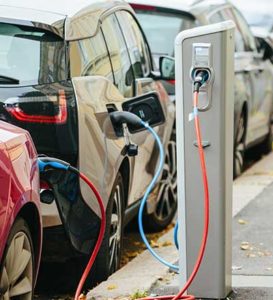ASCE ESTIMATES
n/a
Current Grade
n/a
Trend
n/a
Funding needed to raise to a "B" Grade

Current Grade
Trend
Funding needed to raise to a "B" Grade
 ASCE’s report card does not include a separate infrastructure category or grade for electric vehicles, though it does mention electric vehicle charging stations in its assessment of the electric grid. A baseline of current federal spending on electric vehicles has also not been provided.
ASCE’s report card does not include a separate infrastructure category or grade for electric vehicles, though it does mention electric vehicle charging stations in its assessment of the electric grid. A baseline of current federal spending on electric vehicles has also not been provided.
Senate Republicans did not include investments for electric-vehicle-related infrastructure in their original proposal but have now agreed they should be included. The Common Sense Coalition and the Problem Solvers Caucus also include it. Wide differences remain among the four plans, however, over what to include in the investment and how much to invest.
The American Jobs Plan proposed $17.4 billion in new spending per year for investments in electric vehicles, most of which is divided over three sub-categories. The first sub-category arguably fits the usual understanding that infrastructure includes physical systems built to be broadly available to the public and that help the economy function efficiently. It would provide $1.5 billion per year in grants and incentives for state and local governments to build a national infrastructure of 500,000 electric-vehicle chargers. The other two electric-vehicle sub-categories reflect a broader definition of infrastructure. President Biden proposed $10 billion in new spending per year for rebates and tax incentives to encourage the purchase of American-made electric vehicles. He also proposed $4.5 billion per year to replace diesel transit vehicles with electric ones and to electrify school buses.
The latest proposal by Senate Republicans calls for $0.5 billion per year for electric vehicle charging stations.
President Biden now supports CSC’s plan for $3 billion, half of which would be for charging stations and the other half would be for low and no carbon emission buses and ferries. PSC would invest $3.1 billion for both charging stations and electric buses.
Electric vehicle supporters argue that the technologies both for alternative sources of electricity like solar and wind power as well as for plug-in electric vehicles themselves are improving rapidly. Those technological improvements, they argue, make it smart economically for the nation to move boldly toward electric vehicles. Leading the global market for electric vehicles can be a source of good middle-class jobs for decades to come, the White House suggests, just as U.S. leadership in gas and diesel cars and trucks have provided Americans with good jobs going back to the Ford Model T.
Moving from gas and diesel to electric vehicles that are charged by alternative electricity sources, supporters argue, will also significantly reduce greenhouse gas emissions and be a major step in addressing the challenge of climate change.
Senate Republicans agree that investment in a national infrastructure for electric vehicle charging stations is appropriate for inclusion in an infrastructure package because it fits within the standard definition of the term. Many also agree that moving towards electric vehicles is smart economically and environmentally.
Senate Republicans argue, though, that it is wiser to move more slowly than the Biden Administration proposes, particularly given the massive increases in other federal spending.
Senate Republicans also suggest that the other two electric vehicle parts of the American Jobs Plan investments are both excessive in their amount of federal spending and beyond the definition of infrastructure. Opponents argue that whatever the merits of rebates and tax incentives for purchasing American-made electric vehicles and for electrifying transit vehicles and school buses, they are not for a debate about infrastructure.
The National Renewable Energy Laboratory study estimates the United States will need about 628,000 public chargers to accommodate 15 million electric vehicles by 2030. A 2021 analysis by McKinsey & Company found that globally 48% of plug-in electric vehicles are purchased in China, 35% in the European Union, and 15% in the U.S. The 2020 report by the American Security Project concludes that China’s electric-vehicle strategy has invested far more than the U.S. in electric vehicle infrastructure by installing thousands of charging stations per month. In contrast, the U.S. strategy has focused on technological innovation to build better electric vehicles.